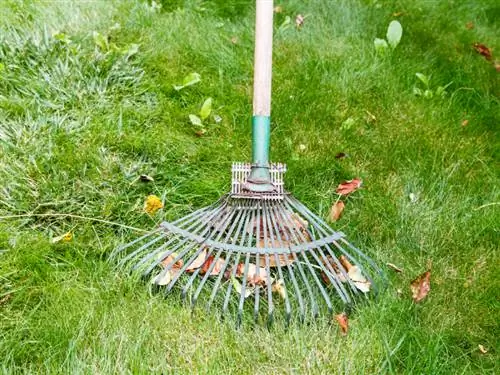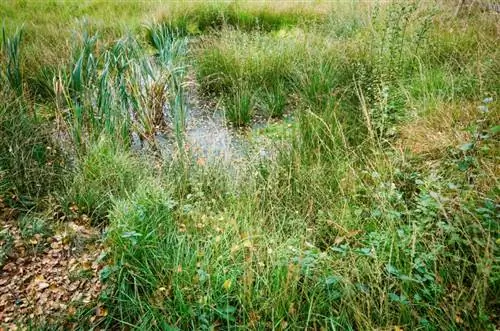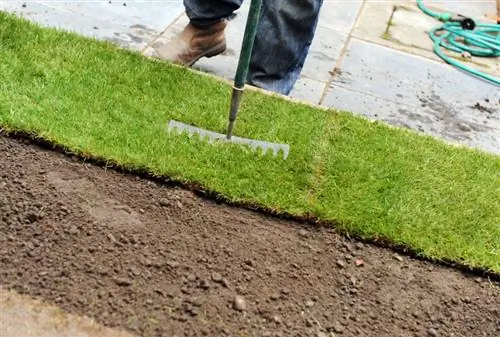- Author admin [email protected].
- Public 2023-12-16 16:46.
- Last modified 2025-06-01 06:02.
The successful creation of a new lawn is one of the ultimate challenges. These instructions show you the practical way to a lush green lawn. How to create a new lawn by sowing or laying turf is no longer hidden from you here.

How do I successfully create a lawn?
To successfully create a lawn, the ground must first be prepared by removing weeds, digging up soil and removing uneven areas. Lawn seeds can then be sown between early May to early June or mid-September to early October. With turf, however, careful preparation and quick installation on the day of delivery are crucial.
Soil preparation for sowing lawn seeds - this is how it works
Creating new lawns by sowing works just like growing vegetables in the garden. To ensure that the sensitive lawn seeds thrive, you should ideally cultivate the soil in the autumn of the previous year for perfect preparation. Here's how to do it:
- On a new building plot, spread the topsoil from the excavation over the planned lawn area
- Dig or mill the soil at least 2 spades deep on existing areas
- Carefully remove stones, roots and weeds
- Optimize loamy-clayey soil with fine, washed sand and peat
- Improve sandy soil with compost and horn shavings
- Rake the budding lawn and let it rest through the winter
Conduct a pH test to determine soil acidity. If the result is below 5.5, add an adequate amount of garden lime to the soil.
When is the right time to sow lawn seeds?
Two appointments a year are recommended if you are creating a new lawn by sowing seeds. From early May to early June and from mid-September to early October, the weather conditions are ideal for rapid germination. The most important prerequisite for good success is a constant soil temperature of more than 10 degrees Celsius.
Each sowing date has individual advantages. If you replant a lawn in spring, the grass roots have plenty of time to grow. If you grow the seeds in the fall, Mother Nature will provide the necessary watering with frequent rains.
The seedlings sprout in this fine subgrade
After the rough subsoil for the new lawn has been created, the soil is given its finishing touches shortly before sowing. Whenever you grow young plants from seeds, the soil should have as fine a crumbly consistency as possible. In this regard, lawn seeds are no exception. How to cultivate the soil with expertise:
- Weed the soil carefully and rake it superficially
- Work the soil with a rake until a fine crumb forms
- If necessary, roll the lawn once as an intermediate step to level larger clumps
If you grow lawn seeds in such finely crumbly soil, you will be able to enjoy a particularly short germination period.
Perfect sowing - step-by-step instructions
If you cultivate the soil before sowing according to these instructions, there are excellent prospects for the further successful development of the new lawn. Ideally, the work tool available is a spreader (€24.00 on Amazon) or a battery-operated hand spreader. The steps continue:
- Mix the seeds vigorously and fill them into the spreader
- Distribute the lawn seeds in a checkerboard pattern without large overlaps
- Only incorporate the light germs superficially with the rake
- Roll the future lawn lengthwise and crosswise
- In the last step, water the seedbed with a fine spray
In the following 3 weeks, the new lawn is gently watered with the lawn sprinkler 4-5 times a day for 10 minutes each. The bed should only be entered for this purpose so that the seeds can germinate in peace.
Tip
Don't puzzle over the optimal sowing rate per square meter for long. If you do not have the specific information for the type of lawn you have chosen, you are in the green with 20-25 grams per square meter of lawn area.
The first care - this is how the new lawn thrives
If you have done everything correctly according to these instructions, the new lawn will result in a densely overgrown lawn covered with busy spreading seedlings. To ensure rapid growth, cultivate young lawns as follows after re-laying:
- Mowing the noble grass for the first time when it is 8-10 centimeters high
- Immediately fertilize the lawn based on the findings of a previous soil analysis
- Watere repeatedly until the fertilizer has been completely absorbed into the soil
If you are re-laying the lawn in spring, we recommend a fertilizer with plenty of nitrogen for growth and phosphate for the rich green color. Creating new lawns by sowing in autumn, on the other hand, requires a potassium-rich nutrient supply to strengthen frost resistance.
New lawn installation with rolled turf - this is how the substructure works
Even if you follow the instructions for creating a new lawn by sowing to the letter, the procedure still takes a few weeks. On the other hand, if you create a new lawn with rolled turf, wasteland will be transformed into a velvety green carpet within a day. Before you lay ready-made turf, cultivate the soil to create the perfect base. This is how it works:
- Dig up or mill the earth about 2 weeks before delivery of the turf
- Remove weeds and rubbish thoroughly and work the soil with a rake
- Incorporate compost, rock dust and sand into the top layer of soil
- Roll the surface and smooth it out with the rake
- Apply a special starter fertilizer for turf and water the area
The new lawn installation with rolled turf offers the unique opportunity to stop cheeky moles in advance. To do this, spread a close-meshed mole net on the substructure so that the edges overlap on the ground. Within 3 weeks, material has developed into an impenetrable barrier for the diggers.
Removing old lawn - how to do it right
If the new lawn with rolled turf is intended to replace a disused lawn area, this must be removed before the substructure is created. For this purpose, the machine rental company has a lawn sod peeler available. How to handle the device:
- Mow the old lawn as short as possible
- Place the lawn peeling machine on a lawn edge
- Switch on the device and slowly walk across the lawn
The ingenious machine ended up cutting the old lawn into strips and peeling off a few centimeters of soil. These are simply rolled up and disposed of. Then prepare the substructure as explained in these instructions.
Give preference to suppliers with pre-cool processes
The new lawn installation with rolled turf is under certain time pressure with regard to harvesting, transport and laying. Immediately after peeling in the field of the turf school, the finished turf begins to wilt. To counteract this, knowledgeable providers have developed the pre-cool process. The finished turf is cooled down to 3 degrees Celsius, which extends the shelf life from 12 hours to 36 hours.
In this way, turf can survive a longer transport route without damage. Regardless, you cannot avoid laying them on the day of delivery, as storing them overnight could prove to be problematic.
Lay your own turf - this is how it’s done
Fresh from the lawn school, turf has a quick expiry date. The green rolls must therefore be laid promptly before the harvest. Delivery should therefore take place early in the morning and the soil should be completely prepared. This is how you lay the green splendor correctly:
- Place the first roll along a straight edge
- Then lay the turf next to each other and offset
- Avoid overlaps, gaps and especially cross joints
- Do not enter open soil before laying
- At the end of each strip, cut the lawn roll to the desired length with a knife
- Last but not least, roll the lawn in both directions
Work your way around the lawn and lay out wooden slats there. These distribute the pressure evenly. Point loads could cause dents in the finished turf, which cannot be repaired afterwards. Leftover pieces of grass are kept until the end in order to close any gaps.
Care begins on the day of installation - that’s what matters
If you lay turf following these instructions, you will have a breathtaking new lawn at the end of the installation day. To ensure that it stays that way, care begins on the same day. How to cultivate turf correctly:
- Water the lawn thoroughly in the evening hours of the laying day
- Apply at least 15-20 liters of water per square meter
- Continue like this for 2 weeks by watering the turf every 2 days
If you are laying new lawn, it should only be walked on for the first 4-6 weeks to place the lawn sprinkler. Only then has the new lawn become sufficiently rooted in the earth that the barbecue party for its inauguration can take place.
Tips & Tricks
However the new lawn is created. It is important to note that the soil rests for at least 14 days before sowing or laying turf so that it can settle. Otherwise, the ground will sag and an uneven lawn will result - a problem that is difficult to repair.






